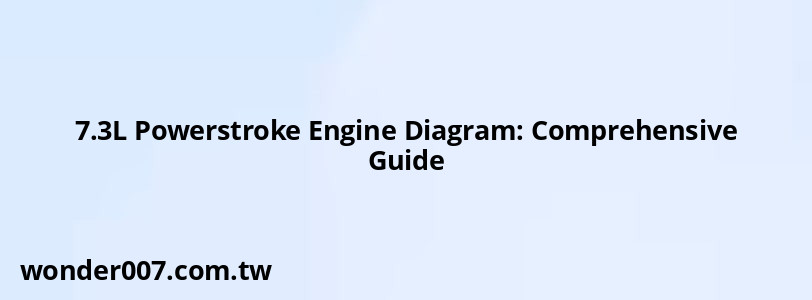7.3L Powerstroke Engine Diagram: Comprehensive Guide

The 7.3L Powerstroke engine, renowned for its reliability and power, has been a popular choice for Ford trucks since its introduction in 1994. Understanding its components and layout is crucial for maintenance and troubleshooting. Let's dive into a detailed breakdown of this iconic diesel engine.
Engine Block and Cylinder Head
The 7.3L Powerstroke features a cast iron engine block and cylinder heads, providing exceptional durability. The engine block houses eight cylinders in a V configuration, with a 4.11-inch bore and 4.18-inch stroke. The cylinder heads contain the valvetrain, consisting of:
- Two valves per cylinder (16 valves total)
- Pushrod-actuated overhead valves
- Hydraulic lifters for automatic valve lash adjustment
Fuel System Components
The heart of the 7.3L Powerstroke's performance lies in its advanced fuel system:
- HEUI (Hydraulic Electronic Unit Injectors): Located in the cylinder heads
- High-pressure oil pump: Mounted on the front of the engine
- Low-pressure fuel pump: Frame-mounted near the fuel tank
- Fuel filter/water separator: Usually located on the driver's side of the engine
Turbocharger and Air Intake
The turbocharging system is crucial for the engine's power output:
- Garrett TP38 turbocharger (1994-1997 models)
- Garrett GTP38 turbocharger with wastegate (1999-2003 models)
- Air intake filter box: Typically mounted on the passenger side
- Intercooler (on later models): Improves air density for better performance
Cooling System
Efficient cooling is essential for the 7.3L Powerstroke's longevity:
- Water pump: Located at the front of the engine
- Thermostat housing: Found on the passenger side of the engine
- Radiator: Positioned at the front of the vehicle
- Oil cooler: Integrated into the passenger side of the engine block
Electrical Components
Several electrical components work together to ensure proper engine function:
- Injector Driver Module (IDM): Usually mounted on the driver's side fender
- Glow plug relay: Located in the engine compartment
- Camshaft Position (CMP) sensor: Found at the front of the engine
- Crankshaft Position (CKP) sensor: Positioned near the flywheel housing
Exhaust System
The exhaust system starts at the engine and includes:
- Exhaust manifolds: One on each cylinder bank
- Up-pipes: Connect manifolds to the turbocharger
- Downpipe: Directs exhaust from the turbocharger to the rest of the system
Understanding the layout and function of these components is crucial for diagnosing issues and performing maintenance on the 7.3L Powerstroke engine. Always refer to the official Ford service manual for detailed diagrams and specific procedures when working on your engine.
FAQs About 7.3L Powerstroke Engine Diagram
- Where is the oil filter located on a 7.3L Powerstroke?
The oil filter is typically located on the passenger side of the engine, near the oil cooler. - How many fuel filters does a 7.3L Powerstroke have?
The 7.3L Powerstroke has two fuel filters: a primary filter/water separator and a secondary filter on the engine. - Where can I find the engine serial number on a 7.3L Powerstroke?
The engine serial number is usually stamped on the passenger side of the engine block, near the cylinder head.
Related Posts
-
P0603 Code: Understanding Keep Alive Memory Issues in 7.3 Powerstroke
26-01-2025 • 189 views -
2011 Ram 1500 Front Sway Bar: Essential Guide
28-01-2025 • 175 views -
Silverado: Fuel Pressure Regulator Location Guide
29-01-2025 • 201 views -
Jeep Grand Cherokee Knock Sensor: Essential Guide for 2008 Owners
30-01-2025 • 198 views -
2013 Hyundai Elantra Oil Filter: Essential Guide
29-01-2025 • 140 views
Latest Posts
-
How To Turn Off Paddle Shifters Mercedes
01-02-2025 • 333 views -
Rear Brake Caliper Piston Won't Compress
01-02-2025 • 312 views -
Are O2 Sensors Covered Under Warranty
01-02-2025 • 338 views -
2015 Chevy Traverse AC Recharge Port Location
01-02-2025 • 365 views -
Power Steering Fluid Leak On Passenger Side
01-02-2025 • 419 views
Popular Posts
-
Power Steering and ABS Light On: Causes and Solutions
27-01-2025 • 610 views -
EPC Light: Understanding Causes and Solutions
26-01-2025 • 1019 views -
EPC Warning Light: What It Means for Your Vehicle
27-01-2025 • 590 views -
Hino Warning Lights: Understanding Dashboard Alerts
26-01-2025 • 632 views -
V12 Engine Costs: What You Need to Know
26-01-2025 • 629 views
